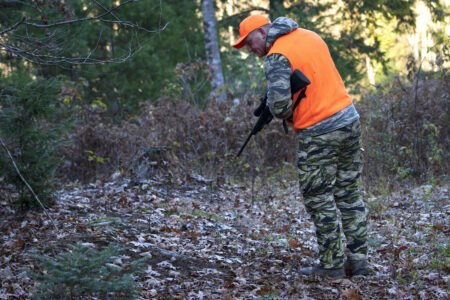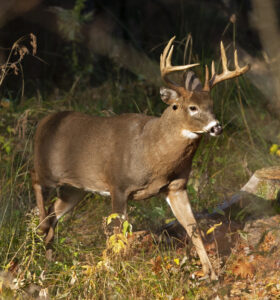Reflections in Nature: It’s the month of August, which means grasshoppers are aplenty
During the month of August, be on the lookout for grasshoppers. These grasshoppers were born in the spring and have been going through many molts to become full-grown grasshoppers.
Most of the musical insects are straight-winged insects except for the cicada. The straight-winged insects undergo an incomplete metamorphosis, which means that the tiny nymphs that hatch from the eggs are already similar in form to their parents. The nymphs gradually take on the appearance of the adults as they increase in size, and on the last molt, they develop wings.
All grasshoppers have well-developed mouths for biting and spitting. Almost everyone has heard that a grasshopper spits tobacco juice. This juice is a brown, sticky liquid, which is digestive juices and plant matter from the grasshopper’s crop. If this tobacco juice gets into the bite, the sting is severe.
The most noticeable body part of a grasshopper is its great hind legs. When a grasshopper jumps, it starts off as a missile but then begins to fly. Powerful thigh muscles are the grasshopper’s catapults. When looking closer at the grasshopper, you will notice the large barbs where the shins join the feet.
These barbs dig into the ground, similiar to the spikes on a sprinter’s shoe, preventing the insect from slipping on take-off.
Grasshoppers have two sets of wings. The more delicate pair act as the propellers. As soon as the grasshopper makes a landing, these delicate wings fold up in pleats and are held along the side of the grasshopper. The upper wings are laid back over them as protective covers.
When the grasshopper lands, the catapults become part of its landing gear.
Later, the grasshopper will use the long hind legs as fiddlesticks. The coarse, outer wings become fiddles. When listening to the grasshopper fiddling away, the sound compares to a series of rasps and is only audible for a few feet.
Only the male has the so-called fiddle-and-bow arrangement, while the male’s calling is heard by the female, with eardrums that are located on each side of her body.
A grasshopper is a good climber due to the spikes on its feet and non-skid devices on the sole of each foot. These pads are minute hollow hairs, which can secrete a sticky substance to help the grasshopper hold fast to grass and plant stems.
The two front feet of the grasshopper are used to hold a grass blade steady while the grasshopper eats, with its sideways-working jaws.
A grasshopper has two kinds of eyes — one set of very small ones used for viewing objects within a few inches of its face and one large pair to see for several yards away on each side. The smaller eyes are known as simple eyes, while the larger eyes are compound eyes because they are made up of thousands of little eyes.
The female grasshopper lays her eggs in the ground in a glue that hardens around the eggs to protect them. This egg mass is called a pod. The female can lay as many as three dozen eggs in a pod and will lay three pods. In the spring when the eggs hatch, they appear as baby grasshoppers, however they lack wings. Young grasshoppers must fend for themselves from the start.
They were born in a protective transparent film known as hatching skin. A young grasshopper struggles up through the glue form and through the dirt to the surface of the ground. Once out of the hole, the grasshopper expands and contracts two swellings on the back of its neck until the transparent covering breaks and falls off its body. The cover is left lying on the ground, and the young grasshopper starts its life.
Within a week, the insect will have its first molt and shed its hard outer covering for a larger size. For the next three weeks, the grasshopper goes through three molts. By then, it is half grown.
By the fourth molt, the first wing stubs begin to appear, and on the fifth molt, its wings are half grown. At approximately six weeks, the grasshopper has its final change of armor. After this molt, it will have a full-length set of wings. This was the last molt, and the grasshopper is now an adult.
Within a week after maturing, the male and female will mate and the female will lay the eggs for another generation.
Grasshoppers are commonly called locusts, but not all grasshoppers are locusts. The main difference between locusts and grasshoppers is the length of the feelers or antennae. Locusts have shorter antennas than those of the grasshoppers.
The Bible tells us that God created an east wind that brought a plague of locust over Egypt. Later, he removed the plague by creating a strong wind, which blew the locust out into the Red Sea.
The locust is one of the most destructive of creatures. A swarm can have an average density of 130 million locust per square mile. They can denude hundreds of square miles quickly, bringing horror, despair and terrible economic consequences to the inhabitants.
Back in the 1870s, a destructive swarm of grasshoppers traveled eastward from the Rocky Mountain region on the easterly winds. Thousands of farms on the plains and prairies had to be abandoned. Between 1874-76, about $200 million worth of farm crops were destroyed. Grasshoppers swarmed along the railroad line, causing engine wheels to spin on the tracks.
Trains could not stop even though the engineers opened the sand-valves wide. The sand would glance off the crowding grasshopper’s back and never reach the tracks. Trains would slide by the station platforms and were delayed for hours. In 1937, the Civilian Conservation Corps, the Work Progress Administration and even the National Guard were called out to help the farmers conquer the grasshoppers.
In eastern Colorado, in 1937, the roadways became hazardous because the grasshoppers made the roads slippery.
Those people residing east of the Rocky Mountains have more problems with grasshoppers than people living west of the mountains. It seems that most of the grasshoppers west of the mountains are sooner or later caught up in a westerly wind, which blows them out into the Pacific Ocean.
Once out over the open water, the grasshoppers fall into the water and drown. If not eaten by gulls and fish, they are washed up in endless rows on the beaches.
As a rule, grasshoppers become too numerous only once in 20 years. In between those times, they are an important item on the menu of many wild creatures, such as skunks, foxes, shrews, songbirds, lizards and salamanders. Grasshoppers are the main item on the menu for a hen turkey and her brood.
With a diet of grasshoppers, the young turkey poults grow fast, and by fall, they have grown almost as big as their mother.
Bill Bower is a retired Pennsylvania Game Commission Wildlife Officer. Read his blog and listen to his podcasts on the outdoors at www.onemaningreen.com.




